Hidden Modernist Landmark in RTP: AATCC Headquarters
Hidden in a leafy green campus of Research Triangle Park is a treasure of a modernist building in the International Style: the headquarters for the American Association of Textile Chemists and Colorists.
The AATCC was founded after the first World War, when it was difficult for European dyes to reach America. The organization and laboratory were housed at the Lowell School of textiles in Lowell Massachusetts. The school was planning to shut down the textiles program in the 1960s, so the AATCC began looking at other locations for headquarters. The options were New York City or Research Triangle Park and after a vote, it was decided RTP would be the final destination.
The textiles industry in North Carolina at the time was huge, so location in a science and research park near this industry made sense.
In 1962, the group commissioned one of the most prolific and accomplished architects in the area, G. Milton Small and Associates, to design their new headquarters in Research Triangle Park.
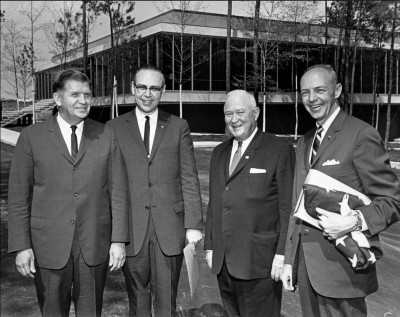
Dedication of AATCC Technical Center, April 24, 1964 from left: Terry Sanford, Governor of North Carolina; Ernest Kaswell; Tom Smith; and George Paine
The building was completed and dedicated in 1964. It was attended by a number of AATCC officials and local dignitaries, including former governor Luther Hodges and the current governor, Terry Sanford.
As a part of the ceremony, Ernest Kaswell of AATCC closed his remarks with the words of the alchemist Johann Joachim Becker, written in 1669:
The chymists are a strange class of mortals, Impelled by an almost insane impulse
To seek their pleasure among smoke and vapour, Soot and flame, poisons and poverty.
Yet among all these evils
I seem to live so sweetly
That may I die if I would change places
With the Persian King.
After the dedication, the entire group adjourned to a reception at the Carolina Country Club (now demolished) which was also designed by G. Milton Small.
In 1965, this building was one of only 8 across the state to receive an AIA-NC Merit Award. In addition to its beautiful design, it was like many of G. Milton Small’s buildings–scalable for future expansion. In this case, the lower level was left unfinished. Due to a meteoric rise in AATCC membership, it was expanded upon just a few years after construction.
In the 237th council meeting on September 23, 1964, Joseph Jones reported that the “total cost of the project had been $225,363 (including land at $30,000 and the architects fee of $16,986), $2,137 under budget.”
From the AATCC publication, Dyeing for a Living:
The building has proved to be an excellent investment for the Association: there have been no major structural problems, the space has been more than adequate (after the basement was finished in the late 1960s), and the value of the land has increased considerably as well.
The plans for the interior layout of the building were completed by fall 1962. […] That layout, with a reception area in the front, a large meeting room in the center, offices to both sides, and a large laboratory area in the rear, is essentially identical to what exists in 1996. Even the locations of the offices of the various staff members are the same.
The building measured 96 by 100 feet and had two levels. Construction was of structural steel and reinforced concrete. The outside walls of the upper level were essentially all glass, tinted for climate control. The interior walls were all demountable partitions, allowing for easy reconfiguration of space. An exterior corridor around the perimeter provided an enclosed overhang, easing temperature control. The lower level was unfinished and was intended for use as expansion space.
This beautiful glass, steel, and poured concrete structure has weathered the decades remarkably well, and continues to serve the needs of the American Association of Textile Chemists and Colorists. While the textiles industry in North Carolina is now only a shadow of what it once was, the location is still strategically placed in a center of research and development–and not far from the College of Textiles at NC State University.

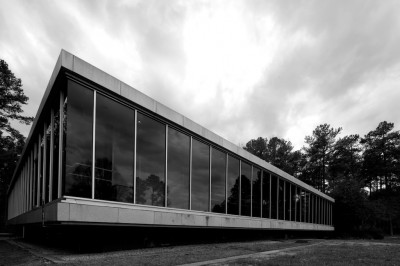
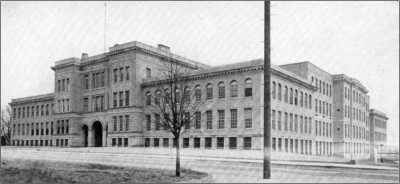
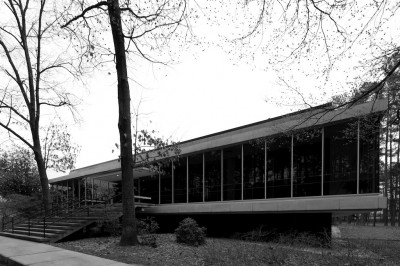
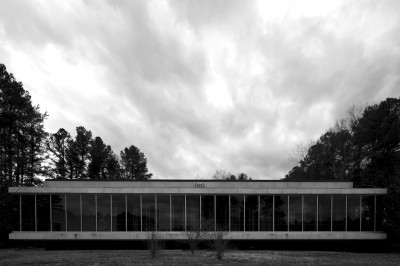
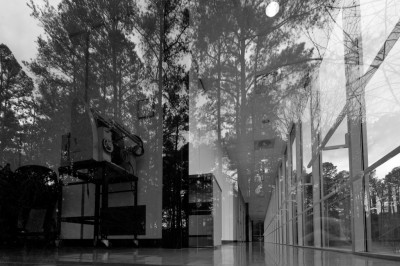


 Sign up for the Newsletter
Sign up for the Newsletter
12/04/2012
Enjoyed reading all the information about AATCC. Remember this building well as I was one of the first staff members when we moved to RTP. Saw it grow over the years. I am now retired from AATCC and still have friends that still work there.
12/05/2012
Note: The Carolina Country Club has *not* been demolished (as stated in the article). Perhaps the building in the linked picture has been demolished, but the CCC has been in the same place (and open) for over 100 years.
12/05/2012
hdog: The Carolina Country Club building linked to was in fact demolished. Demolished is a reference to a building, not an organization. The fact as it was presented still stands.
The CCC building designed by Milton Small was demolished in the early 1990s, about the same time as the passing of the architect, and shortly after the passing of the outspoken proponent of modernist design and nearby resident, Henry Kamphoefner.
It was then replaced with an completely generic and uninspired neoclassical building which stands on the same spot.
12/05/2012
“The Carolina Country Club building linked to was in fact demolished. Demolished is a reference to a building, not an organization. The fact as it was presented still stands.”
False. Please educate yourself. http://www.thefreedictionary.com/demolished
It *can* reference a building, but it’s not inherent in the definition. No reference to a building exists in the following text, so it’s use is ambiguous.
“After the dedication, the entire group adjourned to a reception at the Carolina Country Club (now demolished) which was also designed by G. Milton Small.”
The (original?) building was demolished but not the whole “club”, which includes the rest of the grounds. Hence, my observation.
12/05/2012
Hdog, anal retentive much? LOL
12/05/2012
Unless Milton Small designed the Carolina Country Club as an organization, it’s obvious the reference was referring to the building he designed, not the club it served.
Just sayin’. ;)
12/05/2012
hdog: This is a local blog, not the New Yorker. Pedantic arguments unrelated to the article topic are unwelcome here. Any further comments unrelated to the article will be removed.
12/06/2012
Hdog – Dude, are you ok? *Hugs*